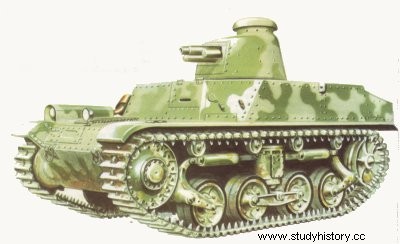
AMR 33 VM, 35 ZT and German variants
Country; France
Type: light tank.
Armament: a 7.5mm machine gun.
Crew: 2 men.
Shielding: 13mm.
Dimensions:
length: 3,504m;
width: 1.6m;
height: 1.727 m.
Weight: 5 t.
Engine: Reinastella 8 cyl. water-cooled gasoline engine, developing 84 hp.
Performance:
maximum road speed: 60 km/h;
vertical obstacle; 0.609 m;
clear cut: 1.524m;
slope: 60%
Service time: introduced in the French army, in 1934-1935, used until the signing of the armistice, in 1940. (Note:the data apply to the AMR 33 VM.)
During the Great War, the French cavalry used armored cars in reconnaissance missions in small groups. But these vehicles lacked off-road mobility and in 1922-23, a call for tenders was launched for a new machine, designated AMC (automitrailleuse de cavalerie).
Industry launched various projects over the next few years but without making much progress.
In 1931, the cavalry established specifications for the three types of vehicle they needed:first, the AMD (discovery armored car), the best example of which was ultimately to be the Panhard AMD 178 armored car; then, the AMR (reconnaissance automitrailleuse), a light tracked, two-seater, to carry a single 7.5 mm machine gun; finally, the AMC (automitrailleuse de combat), to support, thanks to its thicker armor and larger calibers, the lighter AMRs.
Renault produced a small tracked vehicle meeting AMR specifications and, after testing, a production order for 123 units was given in 1933.
These machines were put into service in the French army under the designation AMR Renault 33 VM, La coque. a riveted assembly, housed the driver in the front the captain-gunner in the turret offset on the left of the hull; finally, the engine on the right side The rather uncommon undercarriage featured four road wheels in the centre, a two-wheel bogie, pivoting at the lower end by an upright spring; at the front and at the rear, a single wheel, each on an angled swingarm. Sprocket at the front, tension wheel at the rear and four support rollers.
Further research led to the AMR Renault 35ZT, of which 200 units were manufactured. The machine, weighing 6.5 t, was powered by a Renault 4 cyl. water-cooled gasoline engine, developing 85 hp and giving the vehicle a maximum road speed of 55 km/h. The armament consisted of a 7.5 mm. or a 13.2 mm Hotchkiss, or a cannon
